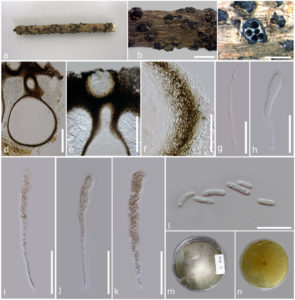Nomenclatural comment: Nom. inval., Art. 40.7 (Melbourne)
Diatrypella vulgaris Trouillas, W.M. Pitt & Gubler (2011)
Saprobic on decaying wood. Sexual morph Stromata 780–1500 μm wide, well developed, in pustules, solitary or gregarious on host, semi-immersed, erumpent through host epidermis, with 3–6 ascomata immersed in a single stroma, comprising of outer, dark brown to black, small, tightly packed, thin parenchymatous cell layer, inner white, loosely packed, parenchymatous cells. Ascomata 255–450 μm diameter (x̅ = 598 × 343 μm , n = 20), perithecial, immersed in stromatic tissues, aggregated, globose to subglobose, sometimes with flattened base, pale to dark brown, ostioles sulcate, only slightly prominent. Peridium 20–44 μm wide (x̅ = 30 μm , n = 20), 2 layered, inner 4–6 layers of hyaline, flattened, elongate, thin-walled cells of textura angularis, outer 6–13 layers of pale to dark brown, flattened, thick-walled cells of textura angularis. Hamathecium comprising 4–7.8 μm wide (x̅ = 5.6 μm , n = 20), septate, paraphyses, tapering towards the apex, wider at the base. Asci 90–130 × 14–19 μm (x̅ = 134 × 16 μm , n = 25), multi-spored, unitunicate, clavate, with long, thin-walled pedicel, with swollen upper portion, apex rounded, without an apical apparatus. Ascospores 4.5–7.5 ×1–2 μm (x̅ = 5.5 × 1.4 μm , n = 20), overlapping, subhyaline, allantoid to cylindrical, unicellular, with small, fat globules at ends, smooth-walled, without sheath or appendages.
Asexual morph Undetermined.
Culture characteristics – Colonies reaching 6.5 cm within 14 days on PDA, at 25 ºC, circular, flat, with diffuse margin, white become light brown with age, reverse similar in colour, not zonate.
Material examined – THAILAND, Chiang Rai, on stems of unidentified plant, 1 January 2015, R.H. Perera, MM-2 (MFLU 17-0737), living culture, MFLUCC 17-0128. GenBank numbers ITS: MF467943; LSU: MF467945; btubulin: MF467947
Notes – In the phylogenetic analysis, strain MFLUCC 17-0128 is closely related to the ex-type strain of D. vulgaris (HVGRF03) and other two strains of D. vulgaris. The comparisons of ITS and b-tub sequence data from both strains show 100% similarity for each gene. Morphologically, strain MFLUCC 17-0128 has similar ascomatal, asci and colony characteristics to those of D. vulgaris, and the only different character is the dimension of the ascospores. Strain MFLUCC 17-0128 has smaller ascospores (4.5–7.5 × 1–2 vs. 8-10 × 2–2.5 μm than D. vulgaris (Trouillas et al. 2011). Diatrypella vulgaris, has been reported from Citrus paradise and Fraxinus angustifolia in Austria (Trouillas et al. 2011), and this is first record of the species in Thailand.
Fig. Diatrypella vulgaris (MFLU 17-0737). a Herbarium material. b Appearance of ascomata on host substrate. c Longitudinal section through stroma. d Vertical section through ascoma. e Close up of the ostiole. f Close up of the peridium. g Paraphyses. h–k Immature and mature asci. l Ascospore. m, n Colony on MEA. Scale bars b = 2 mm, c = 1 mm, d = 200 μm , e–k = 50 μm , l = 20 μm .

